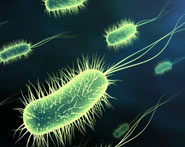


 النبات
النبات
 الحيوان
الحيوان
 الأحياء المجهرية
الأحياء المجهرية
 علم الأمراض
علم الأمراض
 التقانة الإحيائية
التقانة الإحيائية
 التقنية الحيوية المكروبية
التقنية الحيوية المكروبية
 التقنية الحياتية النانوية
التقنية الحياتية النانوية
 علم الأجنة
علم الأجنة
 الأحياء الجزيئي
الأحياء الجزيئي
 علم وظائف الأعضاء
علم وظائف الأعضاء
 الغدد
الغدد
 المضادات الحيوية
المضادات الحيوية|
Read More
Date: 6-11-2016
Date: 29-10-2016
Date: 12-11-2016
|
Pollination and Fertilization
Pollination is the transfer of pollen to the female organs of seed plants. In flowering plants (angiosperms, or “covered seeds”), immature seeds (ovules) are located within carpels. In contrast, nonflowering seed plants have uncovered ovules to which the pollen is transferred, making these “naked seeds” (gymnosperms).

Pollen being released from the anther of a black walnut.
Gymnosperms have simpler pollination as all transmit their pollen by wind. In contrast, angiosperm have a wealth of pollination methods involving many different agents to transfer pollen, including insects (entomophily), birds (ornithophily), bats (chirophily), wind (anemophily), and water (hydrophily). Attraction of animals usually occurs through a conspicuous floral display, with color and scent playing important roles. Yellow and blue flowers tend to attract bees, red flowers attract hummingbirds, pink flowers attract butterflies, and white flowers that stand out at night often attract moths and bats. Animal-based pollination is efficient and usually associated with a food reward to assure a continuing relationship. Frequently, this is a simple symbiotic relationship; however, other plants seem to practice deceit. For example, trap pollinators may hold insects hostage until a flower is pollinated successfully, when they are released. A most unusual mechanism are orchids that seemingly imitate the form and scent of female wasps, attracting amorous male wasps to mount the flower, inadvertently pollinating it. Aquatic plants frequently have filamentous pollen, which is more easily captured in water, and may release male flowers that float freely to their attached female counterparts.
When pollen is deposited on the stigma (in angiosperms) or the ovule (in gymnosperms), it germinates, forming a slender pollen tube through a weakened area of the pollen wall. The pollen tube elongates through “tip extension,” penetrating between cells of the host parent. Within the pollen tube, two nonmotile sperm cells are ultimately formed and are conveyed through the tube, keeping pace with tip growth. The pollen tube uses chemotropic signals to determine the final pathway to the egg cell, deep within the ovule. In angiosperms, pollen tubes penetrate the stigma, style, and ovary until they are amid the ovules. In gymnosperms, pollen germinates directly on the ovule. Pollen tubes enter ovules through a tiny pore called the micropyle and then elongate into the female gametophyte (called the embryo sac in angiosperms). In gymnosperms, the pollen tube directly penetrates the egg cell, but in angiosperms, there are sterile cells in the embryo sac, called synergids, that initially receive the sperm.
At this point, one sperm cell is discharged from the pollen tube and fuses, with the egg cell to form the zygote (the immediate fusion product) and subsequent embryo, which will become the offspring plant. In angiosperms, the second sperm fuses with the central cell to form a nutritive endosperm during double fertilization. The endosperm is needed for successful embryo development.
During fertilization the male and female gametes: (1) contact one another, (2) adhere, (3) cells fuse, and finally (4) nuclei fuse. The act of fertilization triggers embryo development in all plants and endosperm development in angiosperms.
References
Cresti, M., S. Blackmore, and J. L. Van Went. Atlas of Sexual Reproduction in Flowering Plants. Heidelberg: Springer-Verlag, 1992.
Meeuse, B. J. D., and S. Morris. The Sex Life of Flowers. New York: Oxford Scientific Films, 1984.



|
|
|
|
أكبر مسؤول طبي بريطاني: لهذا السبب يعيش الأطفال حياة أقصر
|
|
|
|
|
|
|
طريقة مبتكرة لمكافحة الفيروسات المهددة للبشرية
|
|
|
|
|
|
|
بمشاركة 2000 طالبة.. شعبة مدارس الكفيل الدينية النسوية تجري اختبارات الفصل الأوّل
|
|
|